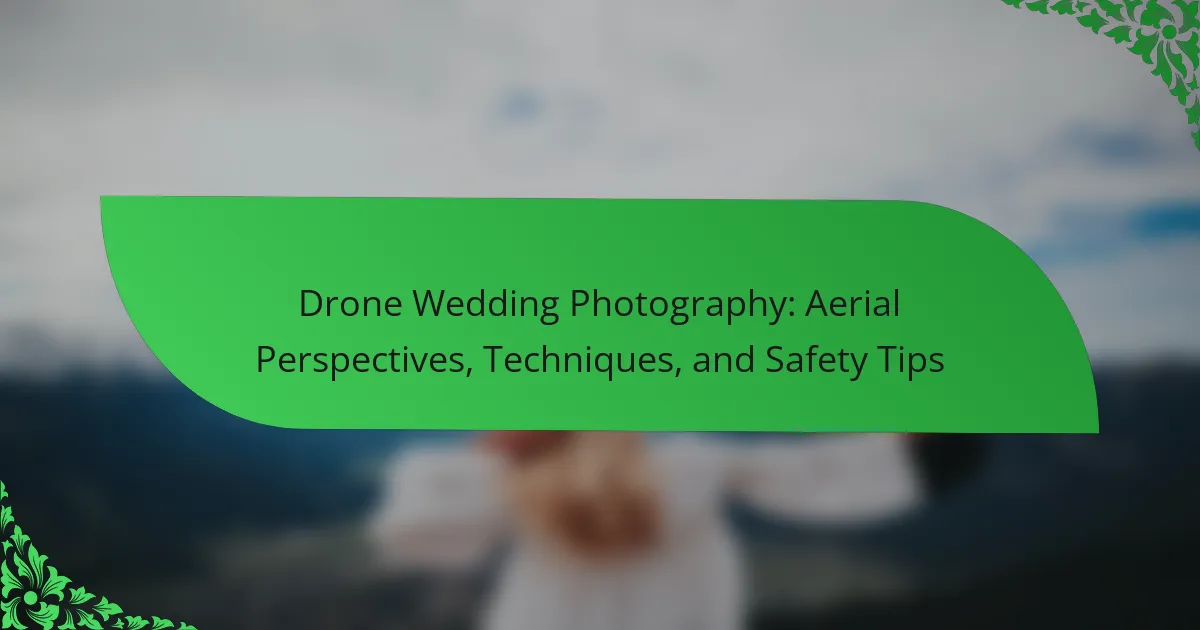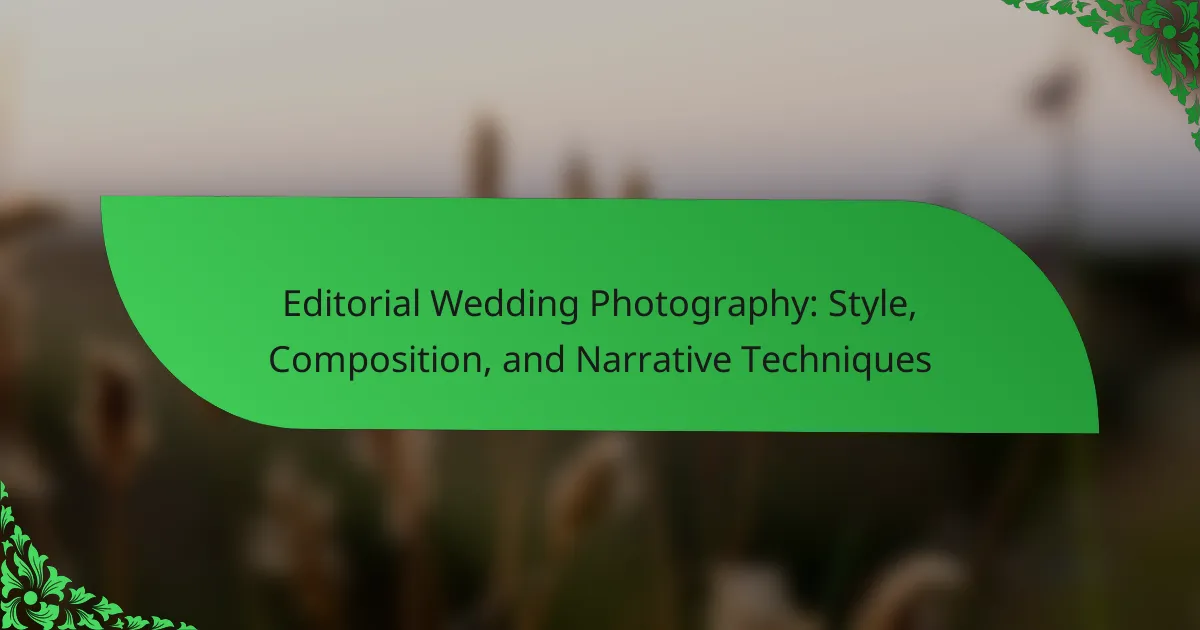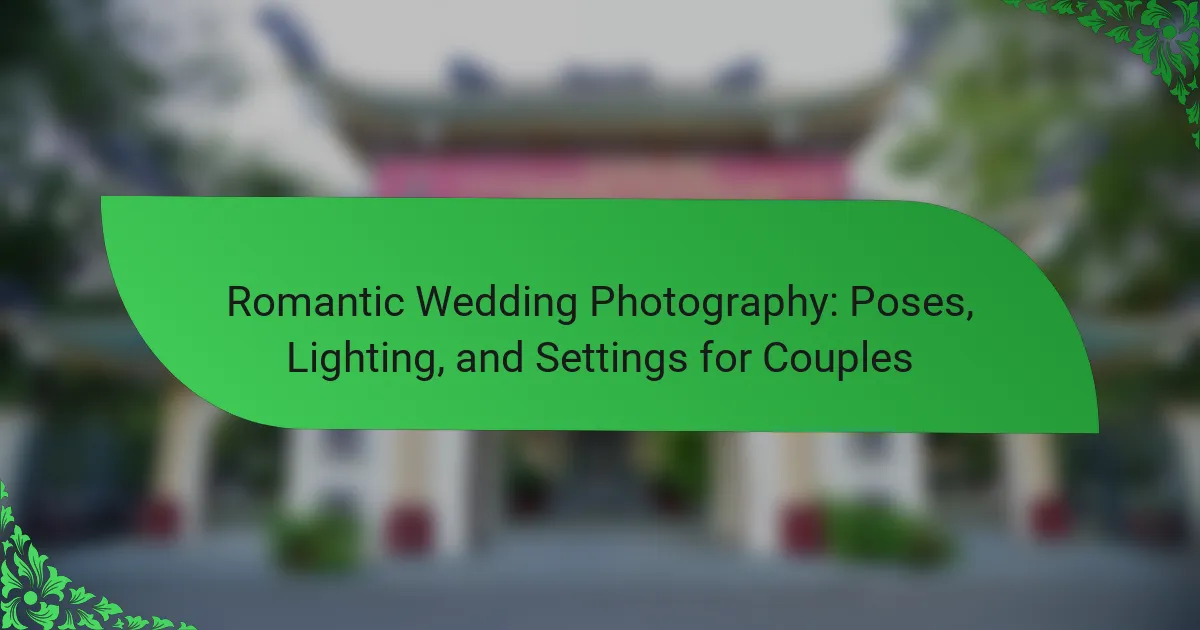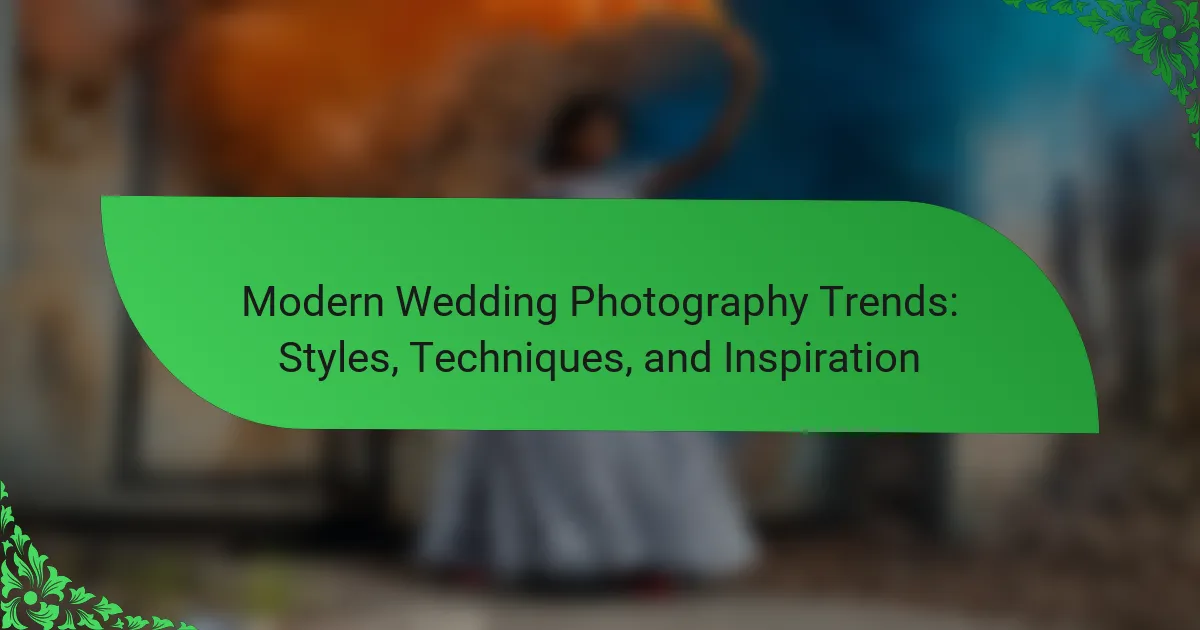Drone wedding photography utilizes drones equipped with high-resolution cameras to capture aerial images and videos of weddings, offering unique perspectives that traditional photography cannot achieve. This method has gained popularity, with approximately 15% of couples incorporating drone photography into their wedding plans, enhancing the storytelling aspect by showcasing the venue and atmosphere from above. Key techniques for successful drone wedding photography include thorough planning, understanding local regulations, mastering aerial composition, and ensuring safety through pre-flight checks and communication with the wedding party. Essential tips also emphasize the importance of smooth flight paths, appropriate camera settings, and practicing maneuvers to ensure high-quality imagery and a safe experience for all attendees.
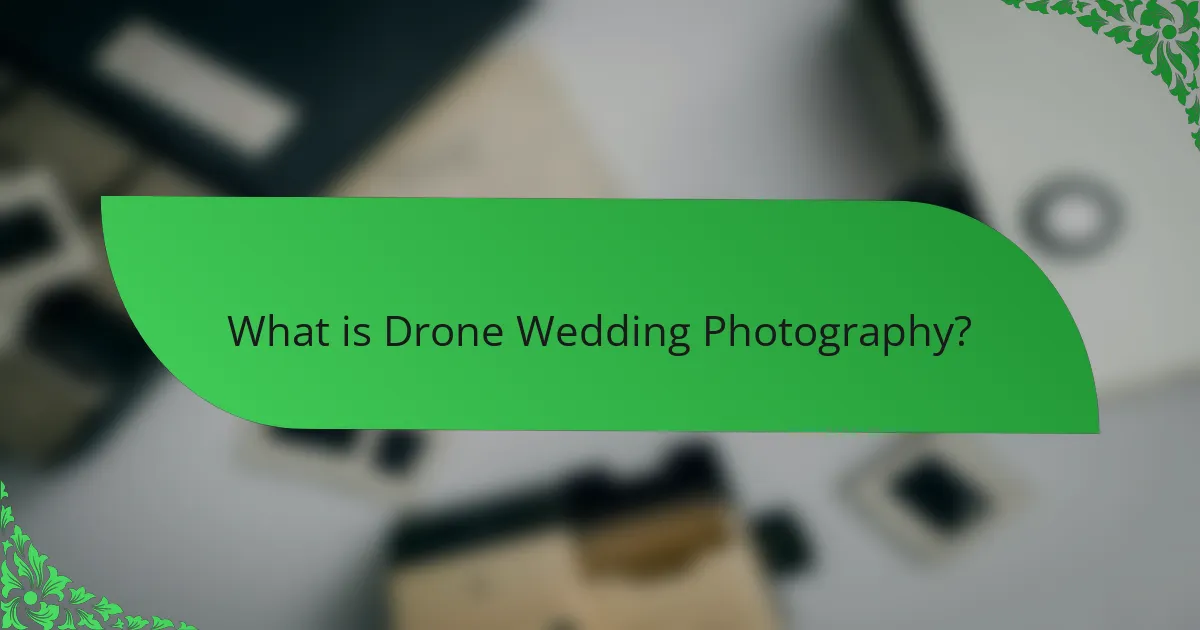
What is Drone Wedding Photography?
Drone wedding photography is a type of photography that utilizes drones to capture aerial images and videos of weddings. This technique offers unique perspectives that traditional photography cannot achieve. Drones can provide sweeping views of the venue, guests, and the couple. They are equipped with high-resolution cameras for quality imagery. The use of drones in weddings has grown in popularity over the years. According to a survey by WeddingWire, about 15% of couples incorporate drone photography into their wedding plans. This method enhances storytelling by showcasing the wedding’s setting and atmosphere from above.
How does Drone Wedding Photography enhance traditional wedding photography?
Drone wedding photography enhances traditional wedding photography by providing unique aerial perspectives. These perspectives capture the entire venue and surrounding landscape, which ground-based photography cannot achieve. Drones can shoot high-resolution images and videos, adding cinematic quality to wedding albums. This technology allows for dynamic shots, such as sweeping views of the ceremony and reception. Additionally, drones can document moments from angles that traditional cameras miss, creating a more comprehensive visual narrative. The use of drones also allows for real-time adjustments to composition and framing, enhancing the overall creativity of the photography. According to a survey by WeddingWire, 70% of couples reported that aerial shots significantly improved their wedding photography experience.
What unique perspectives can drones capture during weddings?
Drones can capture unique aerial perspectives during weddings. They provide overhead shots that showcase the venue layout. This perspective highlights the surrounding landscape and architecture. Drones can also capture dynamic shots of the couple during the ceremony. Aerial views can reveal the guest arrangements and decor from above. They enable sweeping panoramic shots of the entire event. Drones can document the couple’s entrance and exit in a dramatic way. This technology adds a cinematic quality to wedding photography.
How do aerial shots differ from ground-level photography?
Aerial shots capture images from an elevated perspective, while ground-level photography is taken at eye level or below. Aerial photography provides a broader view of landscapes and subjects. It can showcase patterns, shapes, and spatial relationships that are not visible from the ground. Ground-level photography emphasizes details and context from a human perspective. It often conveys emotion and intimacy better than aerial shots. Aerial shots can cover large areas quickly, making them ideal for capturing events like weddings from unique angles. Ground-level photography can focus on individual moments and expressions, enhancing storytelling.
What types of drones are commonly used for wedding photography?
The types of drones commonly used for wedding photography include quadcopters and hexacopters. Quadcopter drones are popular due to their stability and ease of use. They typically have four rotors and can capture high-quality images and videos. Hexacopter drones have six rotors, offering greater stability and payload capacity. This allows them to carry larger cameras for enhanced image quality. Drones like the DJI Phantom series are frequently chosen for their reliability and advanced features. The DJI Mavic series is also favored for its portability and high-resolution capabilities. These drones are equipped with GPS and obstacle avoidance systems, ensuring safe operation during events.
What are the key features to look for in a drone for wedding photography?
Key features to look for in a drone for wedding photography include high-resolution cameras, stable flight capabilities, and long battery life. High-resolution cameras, ideally 4K or higher, ensure detailed and vibrant images. Stable flight capabilities are crucial for capturing smooth footage, especially in windy conditions. Long battery life allows for extended shooting sessions, which is essential during weddings. Additionally, look for drones with obstacle avoidance technology to prevent crashes. Gimbal stabilization is also important for maintaining image clarity during flight. Finally, consider ease of use and portability for quick setup and transport.
How do different drone models impact the quality of wedding photos?
Different drone models significantly impact the quality of wedding photos. Higher-end models typically feature better cameras with higher resolutions. They often have advanced stabilization technology, which reduces image blur. Drones with larger sensors capture more detail and perform better in low light. Specific models may support multiple lenses, offering varied perspectives. Battery life varies among models, affecting the duration of aerial coverage. Some drones provide real-time video streaming, allowing for immediate feedback. The flight stability of a drone model can influence the smoothness of aerial shots. Overall, selecting the right drone model is crucial for achieving high-quality wedding photography.
Why is it important to consider regulations for drone wedding photography?
Considering regulations for drone wedding photography is crucial for legal compliance and safety. Regulations ensure that drone operators adhere to airspace restrictions. They also protect the privacy of individuals during events. Violating these regulations can lead to fines or legal action against the photographer. Additionally, understanding regulations helps avoid accidents and ensures the safety of guests. Following guidelines from organizations like the FAA promotes responsible drone usage. Compliance with local laws fosters trust with clients and venues. Overall, regulations are essential for a successful and lawful drone photography experience.
What legal requirements must photographers adhere to when using drones?
Photographers using drones must adhere to specific legal requirements. These include obtaining a Remote Pilot Certificate from the FAA in the United States. Photographers must also register their drone with the FAA if it weighs over 0.55 pounds. They must fly the drone within visual line of sight at all times. Additionally, flights should not exceed 400 feet in altitude. Photographers must avoid flying over people and restricted airspace without permission. Compliance with local laws and regulations is also necessary. The FAA provides guidelines that must be followed to ensure safety and legality.
How can photographers ensure they are compliant with local drone laws?
Photographers can ensure compliance with local drone laws by researching and understanding the regulations in their area. They should check with local aviation authorities for specific rules regarding drone usage. Photographers must also obtain necessary permits or licenses if required. Familiarity with no-fly zones is essential to avoid restricted areas. Additionally, they should adhere to altitude limits set by regulations. Staying updated on changes in drone laws is crucial for ongoing compliance. Engaging with local drone communities can provide insights and support. Following these steps helps photographers operate legally and safely.
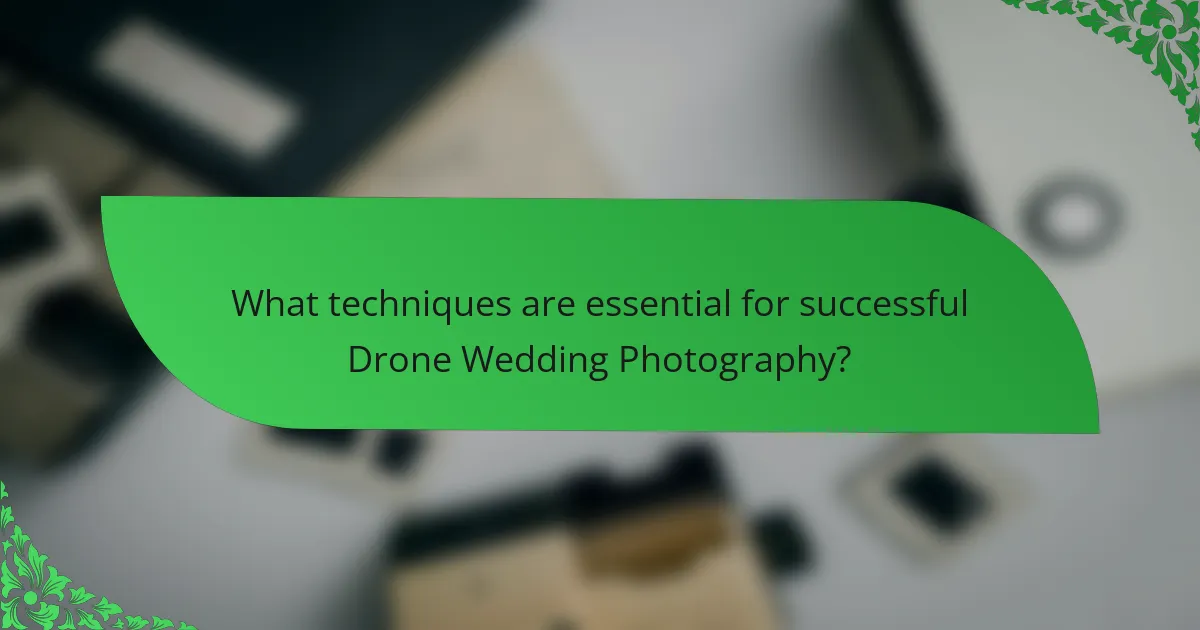
What techniques are essential for successful Drone Wedding Photography?
Essential techniques for successful Drone Wedding Photography include planning, understanding regulations, and mastering aerial composition. Planning involves scouting locations and creating a shot list before the event. Understanding regulations ensures compliance with local laws regarding drone usage. Mastering aerial composition focuses on framing shots effectively from above.
Using smooth flight paths enhances video quality and minimizes jerky movements. Adjusting camera settings for lighting conditions is crucial for capturing clear images. Communicating with the couple and wedding planner aids in capturing key moments. Lastly, practicing maneuvers before the event increases confidence and skill.
How can photographers plan their drone shots effectively?
Photographers can plan their drone shots effectively by conducting thorough pre-flight planning. This includes selecting the right location based on lighting conditions and composition. Photographers should also check local regulations regarding drone use in specific areas. Creating a shot list can help in organizing specific angles and scenes to capture during the event. Additionally, practicing drone maneuvers before the shoot ensures smooth operation during the actual event. Weather conditions should be monitored closely, as they can impact flight safety and image quality. Using flight planning apps can assist in mapping out the desired flight paths. Finally, ensuring that the drone is fully charged and equipped with a backup battery is crucial for uninterrupted shooting.
What factors should be considered when scouting wedding venues for drone use?
When scouting wedding venues for drone use, consider the venue’s location and surrounding airspace regulations. Check if the venue is in an area with restricted airspace, such as near airports or military bases. Assess the venue’s layout to determine suitable takeoff and landing zones. Evaluate the venue’s aesthetic appeal for optimal aerial photography. Confirm if the venue has any specific rules regarding drone usage. Verify the availability of power sources for charging equipment on-site. Consider weather conditions that may affect drone operation. Lastly, ensure that there is adequate space for safe flying without obstructions.
How can timing and lighting affect drone photography during weddings?
Timing and lighting significantly impact drone photography during weddings. Optimal lighting enhances image quality and captures the atmosphere. Golden hour, shortly after sunrise or before sunset, provides soft, warm light. This lighting minimizes harsh shadows and creates flattering images.
Conversely, poor timing can lead to overexposed or underexposed photos. Bright midday sun often results in harsh shadows and washed-out colors. Adjusting the drone’s altitude can help mitigate these effects.
Additionally, timing affects the composition of aerial shots. Capturing key moments, like the ceremony or reception, requires precise coordination. Effective planning ensures the drone is in position at the right time.
In summary, understanding the interplay of timing and lighting is essential for stunning wedding drone photography.
What are the best practices for operating drones during a wedding shoot?
The best practices for operating drones during a wedding shoot include obtaining necessary permits and understanding local regulations. Ensure the drone is registered and complies with FAA guidelines. Conduct a pre-flight inspection to check battery levels and equipment functionality. Plan the flight path in advance to capture key moments without disrupting the ceremony. Maintain a safe distance from guests to avoid accidents. Communicate with the wedding planner and photographer to coordinate timing and angles. Use a spotter to assist with navigation and awareness of surroundings. Lastly, be prepared for changing weather conditions that may affect flight safety. These practices enhance safety and improve the quality of aerial shots.
How can photographers maintain safety while flying drones at events?
Photographers can maintain safety while flying drones at events by adhering to local regulations and guidelines. They should always check for no-fly zones before operating drones. Maintaining a safe distance from people and obstacles is crucial. Photographers must ensure their drones are in good working condition. Pre-flight checks should include battery levels and camera settings. Using visual line-of-sight is essential for safe navigation. Awareness of weather conditions can prevent accidents. Insurance for drone operations can provide financial protection in case of incidents. Following these practices helps mitigate risks during drone photography at events.
What strategies can be used to avoid common drone operation mistakes?
To avoid common drone operation mistakes, operators should conduct thorough pre-flight checks. This includes inspecting the drone for any physical damage. Additionally, ensuring that the battery is fully charged is crucial for safe operation. Operators should also familiarize themselves with the drone’s controls and features before flying.
Maintaining a clear line of sight with the drone is essential to avoid losing control. Understanding local regulations and no-fly zones can prevent legal issues. Planning the flight path in advance helps avoid obstacles and ensures a smooth operation. Lastly, practicing in open areas can build confidence and skill before capturing important events like weddings.
How can photographers edit aerial wedding photos for maximum impact?
Photographers can edit aerial wedding photos for maximum impact by enhancing colors, adjusting contrast, and cropping strategically. Using software like Adobe Lightroom or Photoshop allows for precise color adjustments. Increasing saturation can make the images more vibrant. Adjusting the contrast helps to define the subject against the background. Cropping can focus attention on key elements of the scene. Applying filters can create a specific mood or style. Sharpening the image enhances details, making the photo pop. Finally, using HDR techniques can bring out details in both shadows and highlights. These editing techniques are widely recognized in photography for improving visual appeal.
What software tools are recommended for editing drone wedding photography?
Adobe Lightroom is highly recommended for editing drone wedding photography. It offers powerful tools for color correction and image enhancement. Lightroom supports RAW file formats, which is essential for drone images. Another popular choice is Adobe Photoshop. It provides advanced editing capabilities, including retouching and compositing. Capture One is also favored for its color grading features and tethering capabilities. These tools are widely used by professional photographers for their versatility and effectiveness.
How can editing techniques enhance the storytelling aspect of wedding photos?
Editing techniques can significantly enhance the storytelling aspect of wedding photos. These techniques allow photographers to emphasize emotions and moments captured during the event. For instance, color grading can set the mood, making images feel warmer or cooler. This manipulation of color can evoke specific feelings, enhancing the narrative.
Cropping and framing can focus on key elements, guiding the viewer’s attention. This helps in portraying the significance of moments, such as vows or first dances. Additionally, adding vignettes can draw attention to the couple, creating a more intimate atmosphere.
Using contrast adjustments can highlight details, making expressions and interactions more pronounced. This can lead to a deeper emotional connection for viewers. Furthermore, incorporating textures can add depth and richness to the images, enhancing the overall story.
Finally, sequencing images in a cohesive manner can create a visual narrative flow. This guides viewers through the wedding day, making the experience more engaging. Overall, these editing techniques transform wedding photos into compelling stories that resonate with viewers.
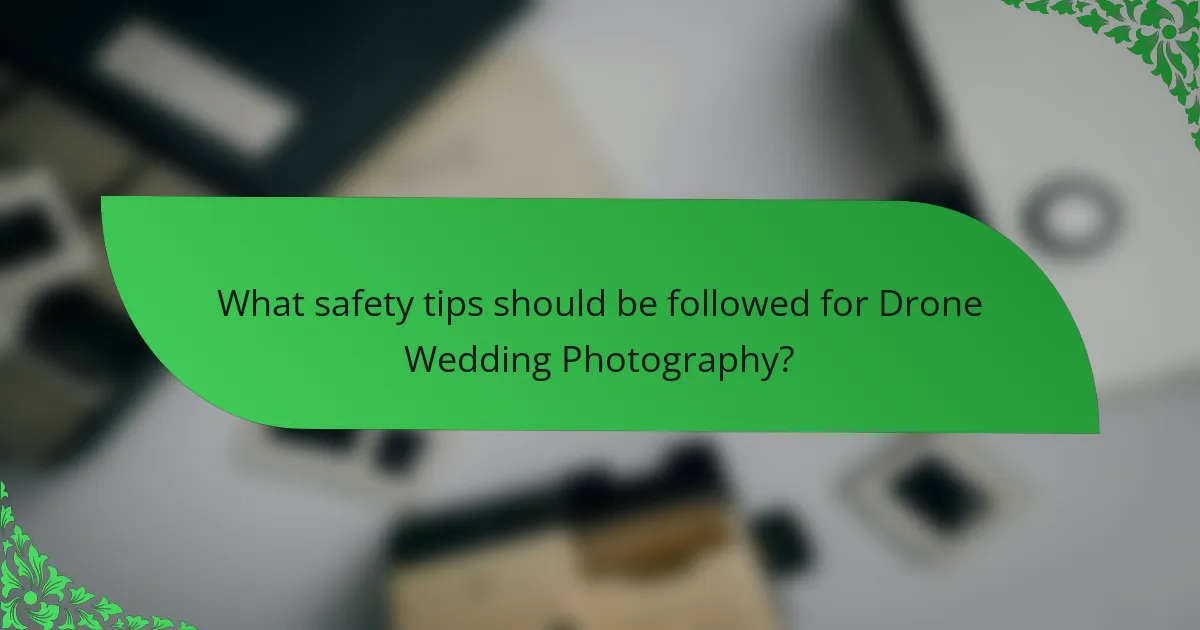
What safety tips should be followed for Drone Wedding Photography?
Ensure compliance with local regulations when using drones for wedding photography. This includes obtaining necessary permits and understanding airspace restrictions. Always conduct a pre-flight check of the drone’s equipment. Check battery levels, propeller condition, and camera functionality. Maintain a safe distance from guests and the wedding venue. This prevents accidents and ensures the safety of attendees. Avoid flying in adverse weather conditions. Wind, rain, or low visibility can compromise safety. Use a spotter to help monitor the drone’s position and surroundings. This additional person can alert the pilot to potential hazards. Lastly, have a clear communication plan with the wedding party. This ensures everyone is aware of the drone’s operation and any potential risks.
How can photographers ensure the safety of guests during drone flights?
Photographers can ensure the safety of guests during drone flights by conducting thorough pre-flight checks. They should assess the flying area for obstacles and potential hazards. Establishing a safe flight zone is crucial. This zone should be away from guests and sensitive areas. Communicating flight plans to guests helps manage expectations. Photographers should also inform guests about the drone’s flight times. Using a spotter can enhance safety by monitoring guests during flights. Following local regulations and guidelines for drone operation is essential. These measures collectively minimize risks associated with drone flights.
What pre-flight checks should be conducted before a wedding shoot?
Conduct pre-flight checks to ensure safety and equipment functionality before a wedding shoot. Verify that the drone battery is fully charged and check the remaining flight time. Inspect the propellers for any damage or debris that could affect performance. Ensure the camera settings are correctly configured for the lighting conditions. Confirm that the GPS signal is strong and stable for accurate positioning. Review airspace regulations to avoid restricted zones during the shoot. Check weather conditions to ensure safe flying, avoiding high winds or rain. Finally, conduct a test flight to confirm the drone’s responsiveness and stability.
How can weather conditions affect drone safety during outdoor weddings?
Weather conditions can significantly affect drone safety during outdoor weddings. High winds can make it difficult to control the drone, leading to crashes. Rain can damage the drone’s electronics, causing malfunctions. Low visibility due to fog or heavy rain can hinder the operator’s ability to see the drone. Temperature extremes can affect battery performance, reducing flight time. Lightning poses a serious risk, as drones can attract electrical discharges. It is essential to monitor weather forecasts before flying. According to the Federal Aviation Administration, safe flying conditions typically include wind speeds below 15 mph and clear visibility.
What are the common challenges faced in Drone Wedding Photography?
Common challenges in drone wedding photography include limited battery life. Most drones have a flight time of around 20 to 30 minutes. This restricts the number of shots that can be taken during critical moments. Weather conditions also pose significant challenges. Rain, high winds, and low visibility can prevent safe operation.
Regulatory restrictions can limit where drones can be flown. Many venues have specific rules regarding drone use. Additionally, capturing candid moments can be difficult from an aerial perspective. Photographers must balance the need for unique shots with the risk of missing important ground-level events.
Technical issues with the drone can arise unexpectedly. Malfunctions can disrupt the shoot and lead to missed opportunities. Lastly, coordinating with the wedding party while flying a drone requires effective communication. This ensures that everyone is aware of the drone’s presence and its impact on the event.
How can photographers troubleshoot connectivity issues with drones?
Photographers can troubleshoot connectivity issues with drones by following several steps. First, they should check the drone’s battery level. A low battery can affect connectivity. Second, they should ensure that the remote controller is fully charged and functioning properly. Third, they should verify that the drone’s firmware is up to date. Outdated firmware can lead to connectivity problems. Fourth, photographers should inspect the environment for potential interference. Obstacles like buildings or trees can disrupt the signal. Fifth, they can try changing the flight location to an area with fewer obstructions. Lastly, resetting the drone and remote controller can resolve connectivity issues. These steps are essential for maintaining a stable connection during flight.
What steps can be taken if a drone malfunctions during a wedding shoot?
If a drone malfunctions during a wedding shoot, the first step is to safely land the drone. Pilots should maintain control and avoid flying it into people or objects. If the drone is unresponsive, use the emergency landing feature if available. Next, assess the situation to determine the cause of the malfunction. Check for low battery, signal loss, or mechanical issues. Communicate with the wedding party to inform them of the situation. If necessary, switch to backup equipment, like handheld cameras. Document the malfunction for future reference and ensure maintenance checks are performed before the next shoot.
What practical tips can enhance the experience of Drone Wedding Photography?
To enhance the experience of drone wedding photography, ensure proper planning and communication. Discuss the couple’s vision and preferred shots beforehand. Scout the location in advance to identify best angles and lighting conditions. Consider the time of day for optimal natural light. Ensure all drone equipment is fully charged and tested prior to the event. Familiarize yourself with local regulations regarding drone usage. Use a second shooter to capture different perspectives simultaneously. Maintain a respectful distance from guests while flying the drone. Lastly, practice flying the drone in similar environments to build confidence and skill.
How can photographers communicate effectively with couples about drone use?
Photographers can communicate effectively with couples about drone use by providing clear information and setting expectations. They should explain the benefits of drone photography, such as unique aerial perspectives and enhanced coverage of the event. Photographers must also discuss safety protocols, including no-fly zones and weather considerations. It’s important to address any concerns couples may have regarding privacy and noise. Visual examples of previous drone work can help illustrate the potential outcomes. Establishing a dialogue allows couples to express their preferences and ask questions. Providing a written agreement outlining drone usage can further clarify expectations. Regular updates during the planning process ensure couples feel informed and involved.
What are the benefits of having a dedicated drone operator at weddings?
Having a dedicated drone operator at weddings provides high-quality aerial photography and videography. This specialized service captures unique perspectives that ground-level photography cannot achieve. A dedicated operator ensures that the drone is flown safely and legally, adhering to local regulations. They can focus on creative angles and compositions, enhancing the overall visual storytelling of the event. This expertise allows for seamless integration of aerial shots into the wedding video. A professional drone operator can also respond to changing conditions, such as lighting or weather, optimizing the footage captured. Studies show that aerial images can significantly increase the perceived value of wedding photography packages. Overall, a dedicated drone operator enhances the wedding experience by delivering stunning, memorable visuals.
Drone wedding photography is a specialized form of photography that employs drones to capture aerial images and videos of weddings, providing unique perspectives that traditional photography cannot achieve. This article covers the advantages of drone photography, including enhanced storytelling and dynamic shots, as well as the types of drones commonly used, key features to consider, and essential techniques for successful operation. Additionally, it addresses important regulations, safety tips, and best practices to ensure compliance and the safety of guests during drone flights. The content emphasizes the significance of planning, communication, and effective editing techniques to maximize the impact of aerial wedding photography.
